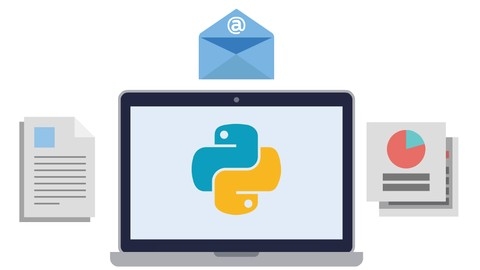NLP - Natural Language Processing with Python
This course covers everything from Python text basics to advanced NLP and deep learning techniques, making it suitable for both beginners and those looking to upgrade their skills.
The course starts with an essential introduction, emphasizing the importance of not skipping the initial lectures to get a clear overview of what’s ahead.
You’ll first tackle text manipulation in Python, learning to work with text files and PDFs, and understanding the role of regular expressions.
This foundation is crucial for anyone new to NLP.
As you progress, the course introduces you to the core of NLP using popular libraries like NLTK and Spacy.
You’ll gain hands-on experience in tokenization, stemming, lemmatization, and handling stop words, equipping you with the skills to preprocess text data effectively.
The curriculum then guides you through specialized NLP techniques such as Part of Speech (POS) tagging and Named Entity Recognition (NER), with practical exercises to solidify your understanding.
You’ll also dive into text classification, learning to apply machine learning models with Scikit-Learn to categorize text, a skill vital for applications like spam detection and sentiment analysis.
Sentiment analysis is another key area covered in the course.
You’ll learn to create semantic word vectors and apply them in a project analyzing movie reviews, a skill highly valued in data analysis and marketing.
Topic modeling is explored next, where you’ll discover unsupervised learning techniques like Latent Dirichlet Allocation and Non-negative Matrix Factorization to uncover hidden topics in text.
This section is particularly useful for content categorization and understanding customer feedback.
The course also introduces deep learning for NLP, teaching you about neural networks, Keras, and how to use models like LSTMs and GRUs for text generation and building chatbots.
This part of the course is ideal if you’re interested in the cutting-edge applications of NLP.
Throughout the course, quizzes, assessments, and projects are provided to test your knowledge and apply what you’ve learned in practical scenarios.
The course concludes with a bonus section, thanking you for your dedication.
Data Science: Natural Language Processing (NLP) in Python
Starting with an introduction to NLP, the course quickly moves to practical advice on succeeding, including where to find code and data, with specific guidance for Windows users.
A solid foundation in machine learning basics sets the stage for applying these concepts to NLP.
You’ll explore classification, regression, and feature vectors, preparing you to tackle NLP tasks with confidence.
The course emphasizes the practical application of these theories, offering hands-on experience in building text classifiers and language models using Markov Models.
For those interested in applying NLP to real-world problems, the course includes projects like decrypting ciphers with genetic algorithms and building a spam detector using Naive Bayes and AdaBoost.
These projects not only solidify your understanding of NLP concepts but also demonstrate their practical utility.
A dedicated chapter on sentiment analysis teaches you to build your own sentiment analyzer, starting from data preprocessing to using logistic regression for predicting sentiments on Amazon reviews.
This section is crucial for understanding how NLP can extract public opinion from text data.
The course also covers the Natural Language Toolkit (NLTK) for Python, guiding you through tasks such as POS tagging, stemming, lemmatization, and named entity recognition.
This toolkit is essential for anyone serious about NLP, and the course provides clear instructions on its use.
Latent Semantic Analysis (LSA) is another highlight, teaching you to perform LSA for data exploration and dimensionality reduction.
This technique is vital for working with large datasets and extracting meaningful insights.
Additionally, the course includes a project on writing your own article spinner using Markov Models and trigrams, showcasing the creative applications of NLP in SEO and internet marketing.
Beyond technical skills, the course offers valuable tips on succeeding in NLP, including setting up your environment with all the necessary tools like Anaconda, Numpy, and TensorFlow.
Natural Language Processing with Deep Learning in Python
The course starts with foundational steps, including a guide on how to navigate the course successfully, access the necessary code and data, and specific advice for Windows users on file management.
This preparation sets a solid ground for what’s to come.
For those new to NLP, there’s a dedicated section on word vectors.
Here, you’ll explore the concept of vectors, word analogies, and how to leverage pre-trained word vectors from GloVe and word2vec.
Understanding word vectors is critical as they form the backbone of NLP tasks.
Building on this foundation, the course revisits language modeling and neural networks.
You’ll get a refresher on bigrams, language models, and their implementation.
This review is crucial for reinforcing your knowledge or bringing you up to speed.
The course then advances to word embeddings, focusing on Word2Vec and GloVe.
You’ll engage with techniques like CBOW, Skip-Gram, and negative sampling, and apply these models using Numpy and TensorFlow.
This hands-on approach not only solidifies your understanding but also equips you with practical skills.
Moreover, the course tackles how to apply neural networks to solve NLP problems, such as Parts-of-Speech (POS) tagging and Named Entity Recognition (NER).
You’ll dive into both the theoretical background and practical implementation in Theano and TensorFlow, broadening your toolkit.
For those interested in cutting-edge topics, the course introduces Recursive Neural Networks (Tree Neural Networks), essential for parsing complex sentence structures.
You’ll learn to construct these networks and apply them to real-world scenarios.
Additionally, the course includes sections on setting up your environment, understanding Theano and TensorFlow basics, and extra Python coding help for beginners.
This comprehensive support ensures you have everything you need to progress confidently.
The course concludes with strategies for effective learning in machine learning and an appendix/FAQ section addressing common questions.
Deep Learning: Advanced Natural Language Processing and RNNs
This course offers a comprehensive exploration of deep learning techniques essential for mastering NLP, presented in a way that’s accessible and engaging.
It kicks off with a friendly introduction, guiding you on how to succeed and where to access all the necessary code.
It’s like having an expert by your side, ready to help you through the learning process.
You’ll dive into key concepts such as Recurrent Neural Networks (RNNs), Convolutional Neural Networks (CNNs), and word embeddings.
These foundational topics are crucial for understanding NLP, and the course provides both theoretical knowledge and practical coding experience.
Special instructions for Windows users are included, ensuring no one is left behind.
Advanced topics like Bidirectional RNNs and Sequence-to-sequence models (Seq2Seq) are also covered.
You’ll see how Bidirectional RNNs enhance image classification and how Seq2Seq models are vital for tasks like machine translation.
The course even revisits poetry generation, offering you a chance to apply these models creatively.
A significant highlight is the section on Attention mechanisms, which improve model performance by focusing on specific parts of the input.
You’ll learn the theory behind Attention, implement it in code, and use it to build a chatbot, all without needing to write additional code.
For those interested in the latest AI developments, the course introduces Memory Networks, showcasing how machines can use past information for decision-making.
The transition into Keras and TensorFlow 2 is smooth, with reviews on building neural networks and converting Keras code into TensorFlow 2.0.
This ensures you’re well-equipped with the skills to use two of the most powerful tools in deep learning.
The course doesn’t just end with technical skills.
It provides a roadmap for further learning, setting you up for continued growth in AI and machine learning.
Additional chapters help with environment setup, Python coding for beginners, and effective learning strategies, acting as your personal guide through the learning process.
Machine Learning: Natural Language Processing in Python (V2)
This course offers a comprehensive dive into Natural Language Processing using Python, making it a great pick whether you’re starting out or aiming to deepen your NLP knowledge.
The curriculum kicks off with NLP fundamentals, ensuring it’s accessible even to beginners.
You’ll learn about processing and manipulating text data, a critical skill since NLP revolves around understanding and generating text.
This foundation is crucial for anyone looking to master NLP, as it covers essential concepts and techniques.
As the course progresses, it introduces more advanced topics, including various machine learning models applicable to NLP tasks.
This section is particularly exciting as it demonstrates how algorithms can interpret human language, predict outcomes, and even create human-like text.
It’s a clear, practical look at the power of combining machine learning with language processing.
What sets this course apart is its practical approach.
You’ll engage directly with Python code, applying what you learn through hands-on projects.
This active learning method solidifies your understanding and enhances your experience by allowing you to tackle real NLP challenges.
Moreover, the course highlights the relevance of NLP in today’s technology landscape, exploring its application in areas like chatbots, sentiment analysis, and more.
This perspective not only makes the learning process engaging but also illustrates the demand for NLP skills in the job market.
Natural Language Processing: NLP With Transformers in Python
This comprehensive course covers everything from setting up your Python environment, whether on a local machine, Google Colab, or with CUDA for GPU acceleration, to advanced NLP techniques using transformers.
It kicks off with an introduction to NLP and transformers, explaining their significance in AI today.
You’ll learn about the evolution of NLP, including key concepts like word vectors, recurrent neural networks, and the groundbreaking self-attention mechanism that transformers use.
Preprocessing text is a critical step in NLP, and this course thoroughly covers techniques such as tokenization, stemming, lemmatization, and Unicode normalization.
These skills are vital for preparing text data for analysis and modeling, setting a strong foundation for more complex tasks.
Practical projects are a core part of the learning experience.
You’ll build a sentiment analysis model using TensorFlow and transformers, classify long texts with BERT, and perform named-entity recognition (NER) with SpaCy and transformers.
These projects give you hands-on experience, applying theoretical knowledge to real-world scenarios.
The course also explores advanced topics like question and answering systems, evaluating language models with metrics like ROUGE, and constructing full Q&A architectures with Haystack.
You’ll learn to assess and refine your models, a crucial skill in NLP.
For those interested in the latest NLP innovations, the course covers similarity search and how to further pre-train transformer models for specific tasks.
This includes measuring semantic similarity and enhancing pre-trained models to improve performance for your unique use cases.
Data Science: Transformers for Natural Language Processing
The course kicks off with an introduction to essential tools like Github and Jupyter Notebook, alongside practical coding exercises.
You’ll learn where to access all necessary resources, including code, notebooks, and data, setting a solid foundation for hands-on learning.
Beginners have a dedicated section that introduces them to the fundamentals of NLP, including the intuition behind RNNs, attention mechanisms, and transformers.
Practical applications such as sentiment analysis, text generation, and more are covered, each accompanied by Python coding sessions to apply what you’ve learned.
For those with intermediate skills, the course dives into fine-tuning transformers, exploring named entity recognition (NER), and POS tagging.
It covers crucial topics like text preprocessing, tokenization, and working with custom datasets.
Additionally, you’ll explore seq2seq models and neural machine translation, gaining both theoretical knowledge and practical skills.
Advanced learners will explore question-answering systems, delve into transformer and attention theory, and learn to implement transformers from scratch.
This section offers a deep dive into the technologies shaping the future of NLP.
The course is structured to provide a smooth learning experience, with each section building upon the previous one.
Extra help sections, FAQs, and learning strategies are available to support you throughout your learning journey.
Modern Natural Language Processing in Python
The course kicks off with an overview of NLP and a detailed look at the curriculum, tools like Colab, and data resources.
An additional section provides a clear learning path, setting you up for success from the start.
One of the first major topics is CNN (Convolutional Neural Networks) for NLP, starting with the basics of CNN and their application in processing text.
You’ll learn how to transition from image processing to text analysis and use CNNs for NLP tasks effectively.
Following this, the course dives into using CNNs for sentiment analysis.
This practical section covers everything from preparing your environment and processing data to building and evaluating your model.
It’s a hands-on approach to understanding how CNNs can be applied to analyze emotions in text.
The course then introduces Transformers, beginning with the fundamental concepts behind them.
You’ll explore attention mechanisms and positional encoding, crucial for grasping how Transformers have revolutionized NLP.
In the application part of Transformers, you’ll engage in real-world NLP tasks.
This includes managing data, tokenizing, and understanding advanced concepts like multi-head attention and the architecture of encoders and decoders.
The focus here is on practical skills, preparing you to implement Transformers in your projects.
Completing the course rewards you with a prize and a coupon for further learning in cloud skills for ML & AI, opening doors to new opportunities.
Hands On Natural Language Processing (NLP) using Python
Starting with a Python Crash Course, you’ll quickly get up to speed on essential programming concepts, including variables, loops, and data structures.
This foundation is critical for tackling the more complex aspects of NLP.
The course then introduces you to regular expressions (Regex), a vital tool for text manipulation.
You’ll learn how to search, edit, and preprocess text data, a skill that’s indispensable in NLP.
As you progress, you’ll explore Numpy and Pandas, two key Python libraries for data analysis.
This knowledge is crucial for managing the large datasets common in NLP projects.
The core of the course focuses on NLP techniques.
Through detailed lectures and hands-on exercises, you’ll master tokenization, stemming and lemmatization, stop word removal, and parts of speech tagging using the NLTK library.
You’ll also dive into text modeling with Bag of Words, TF-IDF, and N-Gram models, and even explore Latent Semantic Analysis.
Practical projects, such as building a text classifier, performing Twitter sentiment analysis, and creating a text summarizer, allow you to apply what you’ve learned in real-world scenarios.
These projects not only reinforce your understanding but also help you develop a portfolio to showcase your skills.
For those interested in the latest NLP trends, the course covers Word2Vec, teaching you how to represent words as vectors.
This section expands your ability to analyze and manipulate text data in innovative ways.
Throughout the course, quizzes help you assess your progress, while comprehensive lectures provide both theoretical knowledge and practical application tips.
U&P AI - Natural Language Processing (NLP) with Python
Starting with an introduction to NLP and its applications, the course quickly moves into practical skills like tokenization, stemming, and lemmatization.
These initial steps are crucial as they teach you how to prepare text data for analysis.
You’ll learn the differences between stemming and lemmatization and how to apply tokenization effectively, setting a strong foundation for more complex topics.
As you progress, the course dives into sentiment analysis, topic modeling, and building NLP models.
You’ll discover how to categorize texts, identify gender from writing styles, and gauge sentiments from text.
The section on topic modeling is particularly engaging, offering insights into uncovering themes in large text volumes.
A key feature of this course is its hands-on approach.
Through exercises on Google Colab, you’ll apply what you’ve learned in real-world scenarios.
The course makes extensive use of tools like WordNet and Word2Vec, enhancing your understanding of word relationships and text meanings.
This practical experience is invaluable, bridging the gap between theoretical knowledge and real-world application.
For those interested in the technical workings of NLP, the course explains concepts like vectorizing and cosine similarity in accessible terms.
You’ll learn how to refine vectors to more accurately reflect document topics, a skill crucial for data analysis and machine learning projects.
Sentiment analysis is another highlight, with detailed discussions on rule-based and machine learning approaches.
This section equips you with the knowledge to implement both methods, an essential skill for roles that require understanding customer sentiment.
Finally, the course addresses semantic search, teaching you to go beyond simple keyword searches to grasp the true intent of queries.
This advanced topic is perfect if you’re looking to deepen your NLP expertise.
Text Mining and Natural Language Processing in R
The course starts with an introduction to R and RStudio.
You’ll get familiar with the course structure, meet your instructor, and access all necessary data and scripts.
This ensures you’re well-prepared to tackle the course material.
Reading data from diverse sources is up next.
You’ll learn to handle CSV, Excel, online CSVs, zipped files, databases, JSON, and PDF documents.
This skill is crucial, as data in the real world comes in various formats, and being adept at processing different types of data is essential for any text mining project.
Webscraping is another key area covered in the course.
Through practical exercises, you’ll use the rvest package to extract data from webpages, scrape data from Google Sheets, and pull information from HTML tables and pages.
This section is invaluable for gathering internet data for your analysis.
API usage to extract text data from sources like the Guardian Newspaper is explained, alongside social media mining techniques.
You’ll learn to extract and analyze data from Facebook and Twitter, including how to set up a Twitter app for data mining.
This is particularly useful for analyzing social media trends or sentiments.
The course also dives into exploring text data, where you’ll work with tweet data, explore text corpora, and learn about text exploration and visualization with tidytext.
This part helps you get a preliminary understanding of your data.
Sentiment analysis is a major focus, where you’ll create word clouds, examine text polarity, and perform topic modeling.
Techniques for visualizing tweet sentiments and analyzing reviews are taught, showcasing the power of NLP in understanding human language.
For those interested in applying machine learning to text data, the course covers clustering, regression, and supervised classification, including spam email identification.
This section is perfect for applying machine learning techniques to text data.
Network analysis is another fascinating topic covered, where you’ll build and visualize networks, such as email and tweet networks.
This shows how data can be interconnected and provides insights into relationships within the data.
Additionally, the course includes lectures on using R within Google Colab, understanding what data science is, and data editing, ensuring a comprehensive understanding of the field.
2024 Natural Language Processing in Python for Beginners
The journey starts with an introduction to machine learning and NLP, focusing on their application in Python.
You’ll learn the roadmap for mastering NLP in Python, setting a clear path forward.
The course ensures you’re equipped with the right tools, guiding you through installing Anaconda and Python 3 across different operating systems.
You’ll also become familiar with Jupyter Notebook shortcuts to streamline your coding process.
A Python crash course is included to solidify your foundation, covering data types, variable and string assignments, lists, sets, tuples, dictionaries, and logical and conditional operators.
This prepares you even if you’re new to Python.
For those interested in data manipulation, chapters on Numpy and Pandas introduce handling arrays, statistical operations, and data frames, equipping you with essential data analysis skills.
At the heart of the course is an extensive section on NLP using Spacy 3.
From tokenization, POS tagging, lemmatization, to named entity recognition (NER), you’ll gain practical skills in processing and understanding text data.
The course also covers word frequency counting, rule-based matching, and effective text file handling.
You’ll apply your knowledge in real-world projects like spam text classification, real-time Twitter sentiment analysis, and resume parsing, bridging the gap between theory and practical application.
For machine learning enthusiasts, the course dives into algorithms such as logistic regression, support vector machines, decision trees, and random forests.
You’ll learn to evaluate models using metrics like accuracy, precision, recall, and confusion matrices, ensuring you can assess and improve your models confidently.
Advanced topics include sentiment analysis using deep learning, emotion recognition, multi-label text classification, and poetry generation with TensorFlow, Keras, and LSTM.
These sections introduce you to the forefront of NLP and machine learning, preparing you for advanced challenges.












